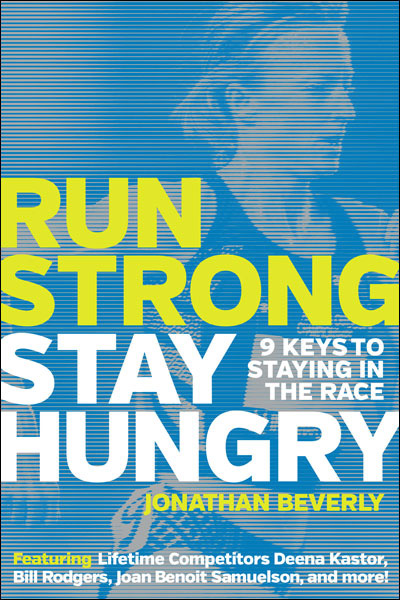Joan Benoit Samuelson eyes sub-3 marathon at 60, book reveals

“Run Strong, Stay Hungry” can be had for $8.89 at B&N.
Jon graciously sent me a review copy of “Run Strong, Stay Hungry,” which distilled the wisdom (sometimes conflicting) of 51 over-50 runners — superstars and no-names alike. (He found some of his subjects via my November 2016 post.) If you have a gift card to Amazon or Barnes & Noble, the book is a great investment.
But not as a how-to-run into geezerhood. It’s more of a why-to-run. (Or how-they-think-it.) Pete Magill, for example, explains how taking a year off to heal some injuries may have bought him a quarter-century more of racing.
Although it’s certainly a motivational book, it’s not a collection of cliches. Quoting real runners and how they persuade themselves to train and race hard is a true act of journalism.
(He also pulls wisdom from academic research. He cites more than 50 article and book references at the end.)
Jon’s book goes way beyond what many “think-piece” texts on the subject do.
Jon shared some chapter samples:
MY BEST TODAY
A race provides one of the best contexts to experience mastery, which is a big reason why lifetime competitors keep competing. “I find great lessons when I push my limits. I learn I can endure more than I ever thought possible,” Deena Kastor said.
It’s notable that while mastery is about doing well, it’s not tied to perfection. You never achieve perfection, but you can achieve mastery on a given day. Mastery is about doing your best given the challenges of that day. Those challenges include time and distance, as always, but also the terrain, the weather, your work schedule, the competition, and even the iffy restaurant food you may have had the night before.
Those conditions also include age. Dealing with being 52 is no different from dealing with a hot, hilly course. Both will result in slower times than a perfect day on a flat course when you’re in the best shape of your life. In the end, the question you answer for yourself is whether you mastered the challenge.
“That is why I keep doing it, this whole test of what it takes to do your best, whatever your best is,” Kevin Paulk told me. Paulk races in masters track meets, with the 800 m his forte. At age 43, he was able to run 1:58. Now, in his 50s, a good time is closer to 2:15.
Slowing times aren’t significant to him, however. The effort and mastery is. “If 2:15 today is the best I could do, then that is victory,” Paulk says. “If I know I ran as hard as I possibly could and I prepared to do that really well, that is absolute victory.”
THE WORLD REDUCED TO A SMALL OVAL
Some masters find tremendous motivation and satisfaction on the track, where age groups are separated into different heats so the field that you are racing is clearly defined (and inevitably well prepared).
Paulk waxed eloquent about the beauty of masters track competition. “For me the drive is competing against other human beings,” he said. “It’s not the clock; it is not how fast did you run. It is how did the race go, racing guys from this line to that line in a footrace.”
When the scope is defined by the group on the track, the challenge and experience are timeless. “For me, it is the joy of being able to compete as if I were Matt Centrowitz [1500m gold medalist at the 2016 Olympics],” Paulk said. “Because we’re all doing the same thing. We’re just not moving as fast! It is quite enjoyable and difficult.”
Paulk says masters racing is even better than open competition because of the respect and camaraderie. “The challenge of pushing yourself to the limit and the joy of toeing the line with people our age is one the most respectful things I’ve ever experienced in a competitive environment,” he said. “We share the same beneficial joy that nothing comes easy. We embrace each other before the gun goes off and after, and we try to kill each other on the track.”





2 Responses
Turns out Joan fessed up to sub-3 goal to Runner’s World and other outlets as well. Maybe Jon was the first to get her on record, though.
https://www.runnersworld.com/masters/joan-benoit-samuelson-is-60-today-and-she-has-an-audacious-goal
Thanks for posting this book Ken. Good timing for 2018 running, racing, and real-living resoultions.
KP
Leave a Reply